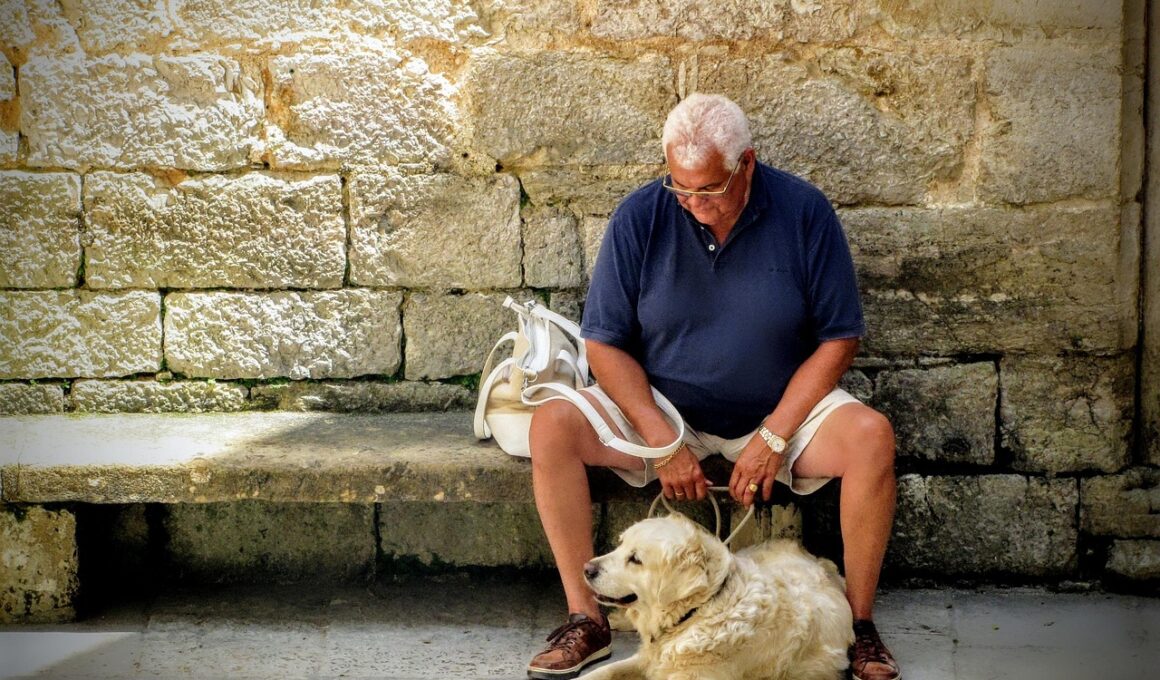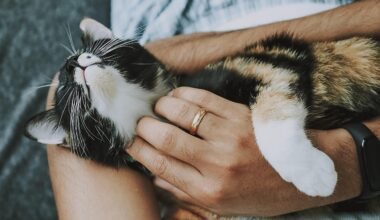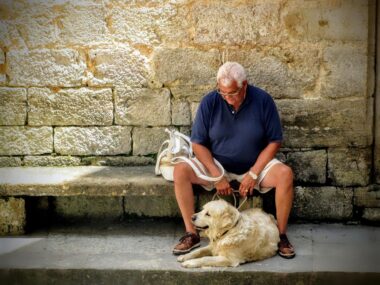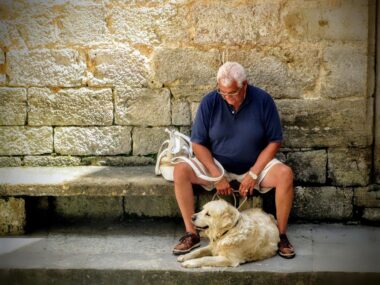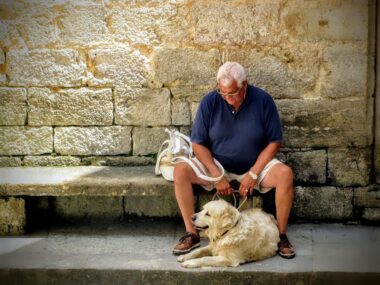Training Tips for Socializing Your Older Dog at Home
Socializing an older dog can seem challenging, particularly if they have not been exposed to various experiences during their formative years. Yet, through patience and the right techniques, you can successfully encourage your older dog to engage positively with both people and other pets. Begin each session in a controlled environment that is familiar to your dog, minimizing distractions. This foundation can significantly ease the stress levels of your beloved pet and help them open up to new encounters. Start with short interactions which can build your dog’s confidence over time. Ensure that your dog feels safe and secure while you introduce them to other animals or people. You can also utilize treats and positive reinforcement to reward good behavior, encouraging them to view new situations as opportunities rather than threats. Keep interactions brief and lighthearted to build a positive association with social situations. Always prioritize your dog’s comfort level and be mindful of their signals. If your dog seems anxious, it’s crucial to take a step back and reassess how to approach the socializing process comfortably.
Continuing from the previous paragraph, one essential technique is managed exposure. This practice enables your older dog to interact with the environment gradually. You can create controlled experiences that involve pairing usual sights, sounds, and smells with treats or praise. For instance, if your dog reacts negatively to other dogs, begin by introducing them to well-mannered dogs who are at a distance. Over time, reduce the gap between them while rewarding your dog for calm behavior. This structured approach prepares your dog for more direct engagements as they become accustomed to varied surroundings. Additionally, utilizing walking trails or parks at quieter times can serve as an excellent opportunity for older dogs to acclimate to other pets and people. Use caution in these scenarios, as an unexpected encounter might result in anxiety. Remember to maintain a steady pace and keep your outings succinct, especially when initially testing your dog’s reaction. Always watch for your dog’s body language, which can provide alerts on their readiness and willingness for further interaction without pushing beyond their comfort zone.
Establishing a Routine
Routines are essential for older dogs’ socialization. Predictability helps reduce anxiety, making it easier for your dog to adapt to new experiences. Start by setting a fixed schedule for socializing sessions, ensuring that you include various activities, such as walks, visits to local parks, or obedience classes. When your dog becomes familiar with their routine, they will anticipate social interactions, allowing for a positive mindset during these encounters. Moreover, integrating socialization within everyday activities fosters a more natural integration into various surroundings. For example, while you perform household chores, allowing your dog to observe from a distance while greeting visitors can help them adapt. Gradually introduce them to family and friends, allowing for controlled interactions. Alongside structured training, incorporating playdates with calm and friendly dogs enhances this process. Monitor your dog closely during these sessions, affirming good behavior with appropriate rewards and praise. Be vigilant about your dog’s comfort level, reducing sessions should they appear overwhelmed. This methodical approach can significantly improve your older dog’s confidence and comfort around others while minimizing the chance of anxiety.
The presence of consistency in training methods is vital to an older dog’s socialization journey. Consistent commands and cues reinforce learning and habits. For instance, use the same verbal cues and body language for commands, which can aid in your dog’s understanding of expectations during social interactions. Communicating clearly helps your dog feel comfortable as they navigate new experiences and learning how to respond appropriately. Additionally, engaging multiple members of the household in socialization exercises ensures that all family members maintain the same approach, which can promote stability. Coordination reinforces your dog’s sense of security as they recognize the familiar cues and commands from every family member. Furthermore, regular socialization within the context of your home and its surroundings is necessary. Begin with low-pressure opportunities such as inviting a friend over to share quality time with your dog, allowing them to connect in a non-threatening environment. Gradually increasing the number of guests or new experiences will further enhance the socialization process, effectively balancing exposure without overwhelming your older dog.
Utilizing Tools for Assistance
To aid in the socialization of older dogs, consider utilizing tools that can enhance comfort and safety during interactions. These may include a reliable leash, harness, or even a muzzle if your dog tends to react defensively. Especially in crowded areas, using a short leash provides more control and an opportunity to intervene if your dog feels overwhelmed. Additionally, a harness rather than a traditional collar can minimize regrettable strain on their necks during unexpected encounters. Muzzles, in situations where a dog displays fear responses or aggressive behavior, can offer a layer of security to both your dog and other animals. Remember that a muzzle doesn’t imply aggression but is instead used as a precautionary measure during training, teaching your dog to feel comfortable in new experiences. Furthermore, you can invest in calming products such as anxiety wraps, pheromone diffusers, or calming treats, which can help alleviate stress during social interactions. Use these tools as additions to your socialization strategy—never rely solely on them but rather incorporate them into well-thought-out plans tailored to your dog’s needs.
Recognizing signs of stress in your older dog is essential for their well-being. Pay attention to their body language, such as yawning, panting excessively, or showing avoidance behaviors like turning their head away. Understanding these signals ensures that you can adjust your approach during socialization efforts to make the experience more enjoyable for your pet. If your dog seems anxious or uncomfortable, it may be necessary to back away from an interaction or lessen the exposures they face. After a particularly stressful session, it could also be beneficial to engage in a calming activity afterward, like gentle petting or a session of relaxation exercises. This practice reinforces the idea that socializing can have pleasant outcomes and alleviates feelings of unease surrounding future interactions. Additionally, reward-based training works wonders to create positive associations. By providing praise and treats when your dog responds favorably to new encounters, you strengthen their willingness to participate in different social situations. This creates a solid foundation of trust between you and your dog, ultimately enhancing their confidence to engage with the world around them.
Celebrate Small Successes
It’s essential to celebrate even the smallest victories throughout your older dog’s socialization journey. Every positive interaction, whether it’s a successful greeting with a new dog or calmly encountering a stranger, deserves acknowledgment. Celebrating these milestones reinforces your dog’s progress and motivates them to continue engaging. You can create a habit of rewarding good behavior immediately following the successful interaction, enhancing their understanding of what positive experiences look like. Celebrations can range from verbal praise, extra playtime, or a favorite treat. Remember that consistency is vital; recognizing and rewarding these moments will lead to larger social successes over time. By focusing on the smaller achievements, you help maintain a positive atmosphere during socialization efforts. It serves as a reminder that socialization is a gradual process and that patience brings positive results. Engage in playful activities with your dog after each successful session to strengthen the bond further. By intertwining this positive reinforcement with socialization, you create a supportive environment where your older dog can thrive and grow, becoming more comfortable and confident in social interactions.
Ultimately, socializing an older dog at home involves a blend of strategy, patience, and keen awareness of their unique needs. Consider your dog’s history and temperament while developing methods that resonate with their personality. As every dog is different, what works for one may not necessarily apply to another, making it vital to remain flexible in your approach. Keep enforcing the techniques that yield success while adapting new strategies that align with your dog’s experiences. An essential aspect is always to prioritize their comfort and emotional safety above all else. As you navigate the socialization journey, remember to equip them with the skills to manage varied interactions as they arise. With time and diligence, your older dog can blossom into a more social pet, relishing new encounters with joy rather than fear. With consistent efforts and a compassionate mindset, socialization becomes a part of your dog’s lifestyle rather than a chore. Embrace every moment as you actively participate in their social growth, observing the transformations that unfold. The bond you create through these shared experiences will deepen, leading to a fulfilling and engaging relationship as your dog embraces its place in the social world.
